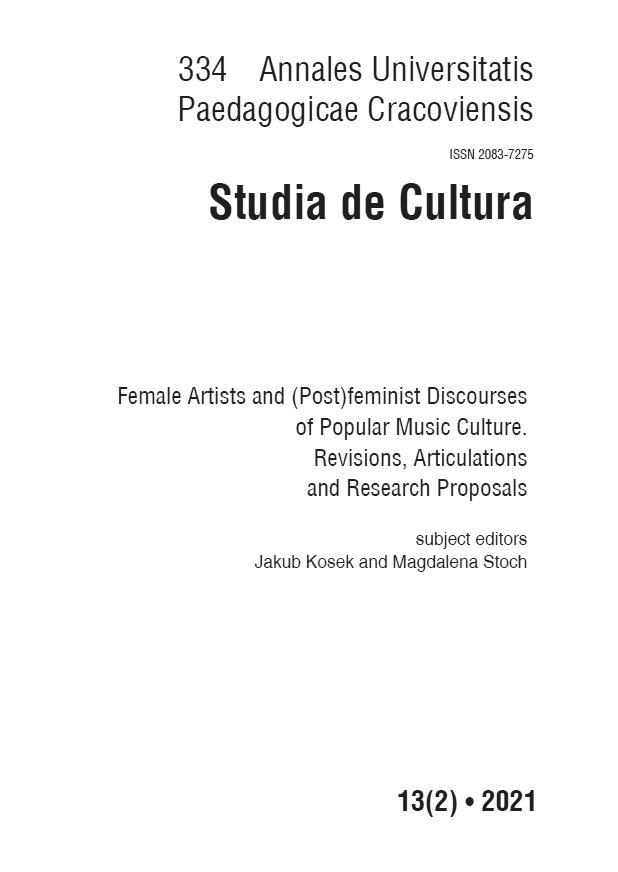Abstrakt
Środowisko baletowe jest bardzo specyficzną społecznością - hermetyczną i niewielką. Analizując historię i literaturę baletową, jak również przyglądając się współczesnym repertuarom wiodących zespołów, łatwo można zauważyć liczebną dominację kobiet, która nie stanowi o ich dominacji w sferze kreacyjnej (choreografia) i zarządczej. W Polsce w sezonie 2019/2020 na czele 6 z 9 największych kompanii baletowych stoją mężczyźni. Jak pokazały badania, to płeć męska od lat dominuje w choreografii, stanowiąc o pokazywanych na scenach spektaklach, a w efekcie o dziedzictwie baletowym. W artykule analizuję rynek pracy polskich choreografek pracujących w wiodących zespołach baletowych, wskazując na panujące nierówności między kobietami i mężczyznami, którzy trudnią się choreografią baletową. W badaniu stosuję metody nauk społecznych (analizę dokumentów - repertuarów i składów osobowych 9 wiodących polskich kompanii baletowych w sezonie 2019/2020), analizuję dane zebrane podczas badania "Szacowanie liczebności artystów, twórców i wykonawców w Polsce" (Ilczuk i in. 2018), a ekonomika kultury stanowi o ramach teoretycznych mojego badania. Baza teoretyczno-metodyczna pozwoliła mi naświetlić nierówności, potencjalne przyczyny i zależności panujące na rynku pracy artystów i artystek tworzących choreografie baletowe. Immanentną cechą tego rynku pozostaje deficyt kobiet.
Bibliografia
Baumol William, William Bowen. 1996. Performing Arts: The Economic Dilemma. New York.
Zobacz w Google Scholar
Berski Jan. 1979. “Conversation with T. Kujawa”. Miesięcznik Literacki 11. 202–209.
Zobacz w Google Scholar
Budrowska Bogusława, Danuta Duch, Anna Titkow. 2003. The Glass Ceiling: Barriers and Restrictions on the Careers of Polish Women. Report from qualitative research, Institute of Public Affairs. Warsaw.
Zobacz w Google Scholar
Czyżewski Krzysztof, Janusz Fogler, Jerzy Hausner, Michał Niezabitowski, Michał Komar, Paweł Łysak, Adam Opatowicz, Robert Piaskowski, Jacek Purchla, Łukasz Ronduda, Joanna Sanetra-Szeliga, Tomasz Szlendak, Aleksandra Szymańska, Bogna Świątkowska. 2020. Alert Culture. Open Eyes Economy Summit. https://oees.pl/wp-content/uploads/2020/04/Alert-Kultura-1-1.pdf (access: 15.07.2020).
Zobacz w Google Scholar
Daly Ann. 1991. “Unlimited Partnership: Dance and Feminist Analysis”. Dance Research Journal no. 23.1.
Zobacz w Google Scholar
Dance Data Project. 208–2019 Season Overview (July 2019).
Zobacz w Google Scholar
Doroszewski Witold. 1966. Słownik języka polskiego. Vol. 8. Warszawa.
Zobacz w Google Scholar
Cholewicka Emilia. 2018. “The role of gender in dance education and the dance market. The perspective of the capital city in the national context”. In: Dance in Warsaw – society, education, culture. Hanna Raszewska-Kursa (ed.). Warsaw.
Zobacz w Google Scholar
Etzkowitz Henry, Carol Kemelgor, Brian Uzzi. 2000. Athena Unbound: The Advancement of Women in Science and Technology. Cambridge.
Zobacz w Google Scholar
Folbre Nancy. 2012. The invisible heart: care and the global economy. In: Women, Gender and Global Development. A Selection of Texts. Nalini Visvanathan, Lynn Duggan, Laurie Nisonoff, Nancy Wiegersma (eds.). Warsaw.
Zobacz w Google Scholar
Frase-Blunt Martha. 2003. “‘Moving past ‘Mini-Me’: building a diverse succession plan means looking beyond issues of race and gender”. HR Magazine no. 48.11.
Zobacz w Google Scholar
Gromada Anna, Dorka Budacz, Juta Kawalerowicz, Anna Walewska. 2015. Poor chances for promotion? A research report on the presence of women at art universities in Poland. Katarzyna Kozyra Foundation. Warsaw.
Zobacz w Google Scholar
Haskell Arnold. 1969. Ballet. Cracow.
Zobacz w Google Scholar
Ibsen Henrik. 2014. A Doll’s House (Nora). In: Selected Dramas. Vol. 1. Warsaw.
Zobacz w Google Scholar
Ilczuk Dorota, Ewa Gruszka, Wojciech Walczak. 2018. Estimating the number of creative and performing artists. Report for the Fryderyk Chopin Institute. Warsaw.
Zobacz w Google Scholar
Ilczuk Dorota. 2012. Ekonomika kultury. Warszawa.
Zobacz w Google Scholar
Kelly Colette LaMonica. 2015. “Dancing Up the Glass Escalator: Institutional Advantages for Men in Ballet Choreography”. Columbia Undergraduate Research Journal no. 2.1. 16 Current initiatives include: She Persisted (English National Ballet), ABT Women’s Movement (American Ballet Theater) or Venus Rising (New Zealand Royal Ballet).
Zobacz w Google Scholar
Jennings Luke. 2013. “Sexism in Dance: Where Are All the Female Choreographers?”. The Guardian online. https://www.theguardian.com/stage/2013/apr/28/women-choreographers-glass-ceiling (access: 2.02.2021).
Zobacz w Google Scholar
Macaulay Alastair. 2017. “Of Women, Men and Ballet in the 21st Century”. The New York
Zobacz w Google Scholar
Times. https://www.nytimes.com/2017/01/12/arts/dance/of-women-men-andballet-in-the–21st-century.html (access: 2.02.2021).
Zobacz w Google Scholar
Macdonald Keith, Colin Tipton. 1993. Using documents. In: Researching Social Life. Nigel Gilbert (ed.). Thousand Oaks.
Zobacz w Google Scholar
Magda Iga, Joanna Tyrowicz, Lucas van der Velde. 2015. Gender wage inequality. Measurement, trends, explanations. Warsaw.
Zobacz w Google Scholar
Marczyński Jacek. 2016. Ten Dancing Women. Grand Theatre – National Opera. Warsaw.
Zobacz w Google Scholar
Meglin Joellen A., Lynn Matluck Brooks. 2012. “Where are all the women choreographers in ballet?”. Dance Chronicle no. 35.1.
Zobacz w Google Scholar
Michael Cooper. 2016. “Breaking the Glass Slipper: Where Are the Female Choreographers?”. The New York Times. https://www.nytimes.com/2016/06/26/arts/dance/breaking-the-glass-slipper-where-are-the-female-choreographers.html (access: 2.02.2021).
Zobacz w Google Scholar
Młodożeniec Marek, Anna Knapińska. 2013. “Does science still have a male gender? Women’s participation in science”. Science no. 2.
Zobacz w Google Scholar
Pudełek Janina. 1981. The Warsaw Ballet from 1867 to 1915. Polish Music Publishing House.
Zobacz w Google Scholar
Teague Jessica. 2016. Where are the female choreographers? A study on the gender imbalance among professional choreographers working in the fields of classical ballet and contemporary dance. http://www.danceicons.org/_doc/FemanleChoreograohers.pdf (access: 2.02.2021).
Zobacz w Google Scholar
Thomas Helen. 2003. Dance, Modernity and Culture. London.
Zobacz w Google Scholar
Throsby David. 2010. Economics and Culture. Olga Siara (transl.). Warsaw.
Zobacz w Google Scholar
Towse Ruth. 2011. Cultural Economics: A Compendium. Horacy Dębowski, Karol Lew Pogorzelski, Łukasz Skrok (transl.) Warsaw.
Zobacz w Google Scholar
Trimarchi Michele. 2016. Market Options and Public Action for Opera. In: The Artful Economist: A New Look at Cultural Economics. Ilde Rizzo, Ruth Towse (eds.). New York.
Zobacz w Google Scholar
Van Dyke Jan. 2017. Dance in America. Gender and Success. In: Dance and Gender: An Evidence based Approach. Wendy Oliver, Doug Risner (eds.). Florida.
Zobacz w Google Scholar
Williams Christine L. 1992. “The Glass Escalator: Hidden Advantages for Men in the ‘Female’ Professions”. Social Problems no. 39.3.
Zobacz w Google Scholar
Xie Yue, Kimberlee A. Shauman. 2003. Women in Science: Career Processes and Outcomes. Cambridge.
Zobacz w Google Scholar

Utwór dostępny jest na licencji Creative Commons Uznanie autorstwa – Użycie niekomercyjne 4.0 Międzynarodowe.

